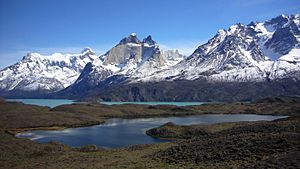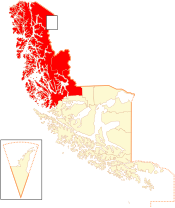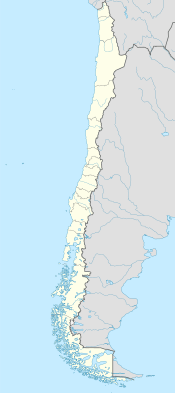Última Esperanza Province facts for kids
Quick facts for kids
Última Esperanza
Provincia de Última Esperanza
|
||
|---|---|---|

Torres del Paine National Park
|
||
|
||

Location in the Magallanes and Antartica Chilena Region
|
||
| Country | ||
| Region | ||
| Capital | Puerto Natales | |
| Communes | Puerto Natales Torres del Paine |
|
| Government | ||
| • Type | Provincial | |
| Area | ||
| • Total | 55,443.9 km2 (21,407.0 sq mi) | |
| Population
(2012 Census)
|
||
| • Total | 18,685 | |
| • Rank | 2 | |
| • Density | 0.337007/km2 (0.872845/sq mi) | |
| • Urban | 16,978 | |
| • Rural | 2,877 | |
| Sex | ||
| • Men | 10611 | |
| • Women | 9244 | |
| Time zone | UTC-3 (CLST) | |
| • Summer (DST) | UTC-3 (CLST) | |
| Area code(s) | 61 | |
| Website | Government of Última Esperanza | |
Última Esperanza (which means "Last Hope Province" in Spanish) is a special part of southern Chile. It's one of four provinces in the Magallanes and Antártica Chilena area. The main city and capital of this province is Puerto Natales. The province got its name from a nearby body of water called Última Esperanza Sound. Part of its border with Argentina, located in the Southern Patagonian Ice Field, is currently being discussed between the two countries.
Contents
How Última Esperanza is Governed
Última Esperanza is like a big district or area within Chile. It's a "second-level administrative division". This means it's a major part of the region, but not a region itself.
Local Areas: Communes
The province is split into two smaller areas called comunas. These are like local towns or districts. The two communes in Última Esperanza are:
Who is in Charge?
A person chosen by the President of Chile manages the province. This person is called the governor. For a while, Ana Ester Mayorga Bahamonde was the governor, chosen by President Sebastián Piñera. Now, Ericka Farías Guerra is the Provincial Presidential Delegate.
Amazing Places to See
Última Esperanza is famous for its incredible natural beauty and important historical sites.
Torres del Paine National Park
This province is home to the famous Torres del Paine National Park. It's known for some of the most amazing mountain peaks in South America, like Cerro Torre and Cerro Chaltén. Imagine towering mountains, bright blue glaciers, and beautiful lakes!
Giant Glaciers
You can also find a part of the Southern Patagonian Ice Field here. This is one of the biggest glaciers in the world outside of the North and South Poles. It's a massive sheet of ice that covers a huge area.
Ancient History at Cueva del Milodón
Another cool spot is the Cueva del Milodón Natural Monument. This is a cave where scientists have found proof that people lived there a very, very long time ago. It's like a window into the past, showing us how prehistoric humans lived.
See also
 In Spanish: Provincia de Última Esperanza para niños
In Spanish: Provincia de Última Esperanza para niños



